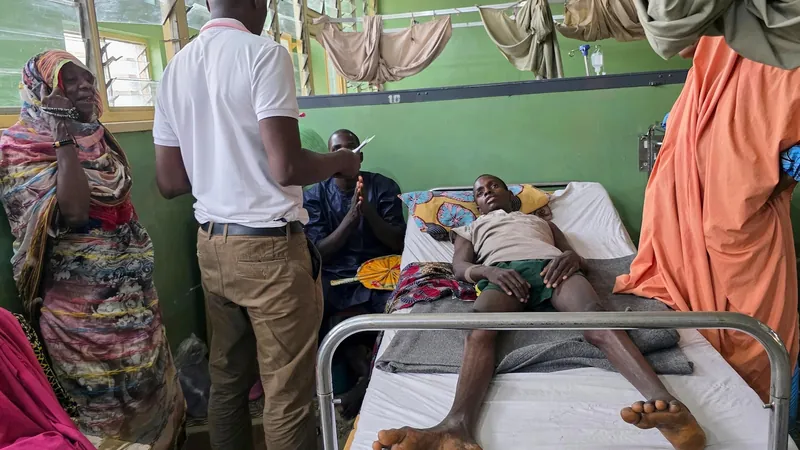
A Comprehensive Guide to Children's Vaccines: What Every Parent Needs to Know
2025-03-27
Author: Daniel
Types of Vaccines
1. Live Attenuated Vaccines: These use a weakened form of the virus, prompting a robust immune response without causing severe illness. Examples include the MMR (measles, mumps, and rubella) vaccine and the varicella (chickenpox) vaccine. While they may cause mild side effects like a fever or rash, serious complications are rare.
2. Inactivated Vaccines: These vaccines contain killed versions of the pathogens. Common examples include the influenza vaccine and the polio vaccine. They safely induce immunity without the risk of disease.
3. Subunit Vaccines: Targeting specific parts of pathogens, subunit vaccines include the hepatitis B and HPV vaccines. They stimulate an immune response to key proteins, providing effective immunity.
4. Toxoid Vaccines: These focus on neutralizing toxins produced by bacteria rather than the bacteria itself. Diphtheria and tetanus vaccines are classic examples, helping the immune system respond effectively to these dangerous substances.
Why Vaccine Dosing Varies
Different vaccines require a varying number of doses, primarily based on how robustly they stimulate the immune system. Live attenuated vaccines typically need fewer doses due to their strength. For instance, a single dose of rubella vaccine offers about 97% efficacy. Conversely, toxoid and subunit vaccines often require multiple doses to build a strong and lasting immune response.
Timing of Vaccines
Vaccination schedules are carefully designed considering several factors: - **Disease Burden**: Identifying the age group most at risk for severe outcomes. - **Immunogenicity**: Timing immunization to ensure a strong immune response, such as delaying the measles vaccine until a child is between 12 and 15 months old to avoid interference from maternal antibodies. - **Ease of Coverage**: Creating a schedule that minimizes clinic visits and maximizes vaccine uptake.
Early Vaccination for Measles
In light of recent measles outbreaks, especially in areas like West Texas and New Mexico, some parents might inquire about vaccinating younger infants. The measles vaccine can be administered as early as six months for at-risk children, particularly those traveling internationally. Nevertheless, follow-up doses are essential at the recommended ages for lasting immunity.
Safety of Simultaneous Vaccinations
Receiving multiple vaccines at once is safe and commonplace. Extensive research supports their combined use without interfering with each other, although mild side effects such as fever or soreness at the injection site may occur.
Vaccine-Derived Immunity vs. Natural Infection
Vaccination offers superior immunity compared to diseases acquired through natural infection. For instance, while measles can lead to severe complications, the vaccine effectively trains the immune system without the associated health risks.
Community Protection Through Herd Immunity
Vaccination is not just personal—it's communal. The principle of herd immunity ensures that high vaccination rates in a community protect vulnerable populations, including infants, elderly individuals, and those with compromised immune systems. A decline in vaccination rates can jeopardize this protection, increasing the risk of outbreaks.
Preventing Measles Outbreaks
To maintain the current low incidence of measles in the U.S., two critical elements are needed: a community with a high vaccination rate and the absence of infected individuals entering from regions where measles is active. An observed drop in vaccination rates could lead to more frequent outbreaks, elevated by the resurgence of measles cases in other countries.
The Importance of Understanding Vaccines
As one of humanity's great achievements, vaccines have saved millions of lives globally. It is vital for parents and individuals to appreciate the importance of vaccines and the potential consequences of neglecting them. The misinformation surrounding vaccines can undermine public health efforts, allowing preventable diseases to resurface.
In conclusion, the understanding and advocacy for vaccines are essential not only for individual health but also for public safety. Let's prioritize the well-being of our children and communities by embracing vaccination as a powerful tool against preventable diseases.





 Brasil (PT)
Brasil (PT)
 Canada (EN)
Canada (EN)
 Chile (ES)
Chile (ES)
 Česko (CS)
Česko (CS)
 대한민국 (KO)
대한민국 (KO)
 España (ES)
España (ES)
 France (FR)
France (FR)
 Hong Kong (EN)
Hong Kong (EN)
 Italia (IT)
Italia (IT)
 日本 (JA)
日本 (JA)
 Magyarország (HU)
Magyarország (HU)
 Norge (NO)
Norge (NO)
 Polska (PL)
Polska (PL)
 Schweiz (DE)
Schweiz (DE)
 Singapore (EN)
Singapore (EN)
 Sverige (SV)
Sverige (SV)
 Suomi (FI)
Suomi (FI)
 Türkiye (TR)
Türkiye (TR)
 الإمارات العربية المتحدة (AR)
الإمارات العربية المتحدة (AR)